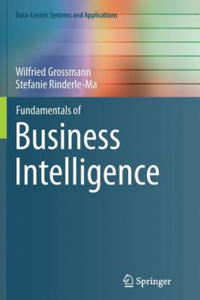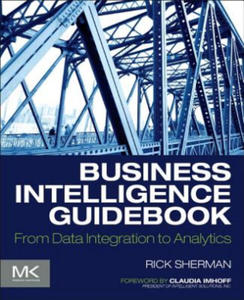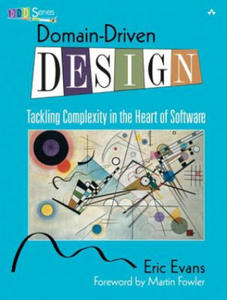libristo essential business process modeling 4109273
- znaleziono 7 produktów w 1 sklepie
Modern Business Process Automation Springer-Verlag Berlin and Heidelberg GmbH & Co....
Książki / Literatura obcojęzyczna
Topics covered include: The fundamentals of business process modeling, including workflow patterns, an in-depth treatment of process flexibility, including approaches to dealing with on-the-fly changes, unexpected exceptions, and constraint-based processes, Technological aspects of a modern BPM environment, including its architecture process design environment, process engine, resource handler and other support services a comparative insight into current approaches to business process modeling and execution such as BPMN, EPCs, BPEL, jBPM, OpenWFE, and Enhydra Shark, process mining, verification, integration and configuration; and case studies in health care and screen business.
Sklep: Libristo.pl
Fundamentals of Business Intelligence Springer-Verlag Berlin and Heidelberg GmbH & Co....
Książki / Literatura obcojęzyczna
This book presents a comprehensive and systematic introduction to transforming process-oriented data into information about the underlying business process, which is essential for all kinds of decision-making. To that end, the authors develop step-by-step models and analytical tools for obtaining high-quality data structured in such a way that complex analytical tools can be applied. The main emphasis is on process mining and data mining techniques and the combination of these methods for process-oriented data.§§After a general introduction to the business intelligence (BI) process and its constituent tasks in chapter 1, chapter 2 discusses different approaches to modeling in BI applications. Chapter 3 is an overview and provides details of data provisioning, including a section on big data. Chapter 4 tackles data description, visualization, and reporting. Chapter 5 introduces data mining techniques for cross-sectional data. Different techniques for the analysis of temporal data are then detailed in Chapter 6. Subsequently, chapter 7 explains techniques for the analysis of process data, followed by the introduction of analysis techniques for multiple BI perspectives in chapter 8. The book closes with a summary and discussion in chapter 9. Throughout the book, (mostly open source) tools are recommended, described and applied; a more detailed survey on tools can be found in the appendix, and a detailed code for the solutions together with instructions on how to install the software used can be found on the accompanying website. Also, all concepts presented are illustrated and selected examples and exercises are provided.§The book is suitable for graduate students in computer science, and the dedicated website with examples and solutions makes the book ideal as a textbook for a first course in business intelligence in computer science or business information systems. Additionally, practitioners and industrial developers who are interested in the concepts behind business intelligence will benefit from the clear explanations and many examples.
Sklep: Libristo.pl
Fundamentals of Business Intelligence Springer-Verlag Berlin and Heidelberg GmbH & Co....
Książki / Literatura obcojęzyczna
This book presents a comprehensive and systematic introduction to transforming process-oriented data into information about the underlying business process, which is essential for all kinds of decision-making. To that end, the authors develop step-by-step models and analytical tools for obtaining high-quality data structured in such a way that complex analytical tools can be applied. The main emphasis is on process mining and data mining techniques and the combination of these methods for process-oriented data.After a general introduction to the business intelligence (BI) process and its constituent tasks in chapter 1, chapter 2 discusses different approaches to modeling in BI applications. Chapter 3 is an overview and provides details of data provisioning, including a section on big data. Chapter 4 tackles data description, visualization, and reporting. Chapter 5 introduces data mining techniques for cross-sectional data. Different techniques for the analysis of temporal data are then detailed in Chapter 6. Subsequently, chapter 7 explains techniques for the analysis of process data, followed by the introduction of analysis techniques for multiple BI perspectives in chapter 8. The book closes with a summary and discussion in chapter 9. Throughout the book, (mostly open source) tools are recommended, described and applied; a more detailed survey on tools can be found in the appendix, and a detailed code for the solutions together with instructions on how to install the software used can be found on the accompanying website. Also, all concepts presented are illustrated and selected examples and exercises are provided.The book is suitable for graduate students in computer science, and the dedicated website with examples and solutions makes the book ideal as a textbook for a first course in business intelligence in computer science or business information systems. Additionally, practitioners and industrial developers who are interested in the concepts behind business intelligence will benefit from the clear explanations and many examples.
Sklep: Libristo.pl
Business Intelligence Guidebook Elsevier Science & Technology
Książki / Literatura obcojęzyczna
Between the high-level concepts of business intelligence and the nitty-gritty instructions for using vendors' tools lies the essential, yet poorly understood layer of architecture, design, and process. Without this knowledge, Big Data is belittled - projects flounder, are late, and go over budget. Business Intelligence Guidebook: From Data Integration to Analytics shines a bright light on an often neglected topic, arming you with the knowledge you need to design rock-solid business intelligence and data integration processes. Practicing consultant and BI professor Rick Sherman takes the guesswork out of creating systems that are cost-effective, reusable, and essential for delivering vital Big Data into the hands of business decision-makers. After reading this book, you will be able to design the overall architecture for functioning data warehousing, business intelligence, and data-integration systems. You will have the information you need to plan, budget, and manage a successful business intelligence program through its entire lifecycle, and build and implement data integration and BI systems that are cost-effective, on-time, and increase the business ROI of Big Data.Finally, you'll give your career a boost by demonstrating essential knowledge that puts corporate BI projects on a fast-track to success. * Provides practical guidelines for building successful BI, DW and data integration solutions * Explains underlying BI, DW and data-integration design, architecture, and processes in clear, accessible language * Includes the complete project development lifecycle that can be applied at large enterprises as well as at small- to medium-sized businesses * Describes best practices and application to various real-life situations* Companion website includes exercises and problem-solution sets with vendor agnostic data modeling examples, as well as a sample syllabus and slides for instructors
Sklep: Libristo.pl
Domain-Driven Design Pearson Education
Książki / Literatura obcojęzyczna
Eric Evans has written a fantastic book on how you can make the design of your software match your mental model of the problem domain you are addressing. His book is very compatible with XP. It is not about drawing pictures of a domain; it is about how you think of it, the language you use to talk about it, and how you organize your software to reflect your improving understanding of it. Eric thinks that learning about your problem domain is as likely to happen at the end of your project as at the beginning, and so refactoring is a big part of his technique."The book is a fun read. Eric has lots of interesting stories, and he has a way with words. I see this book as essential reading for software developers-it is a future classic." -Ralph Johnson, author of Design PatternsIf you don't think you are getting value from your investment in object-oriented programming, this book will tell you what you've forgotten to do."Eric Evans convincingly argues for the importance of domain modeling as the central focus of development and provides a solid framework and set of techniques for accomplishing it. This is timeless wisdom, and will hold up long after the methodologies du jour have gone out of fashion." -Dave Collins, author of Designing Object-Oriented User Interfaces"Eric weaves real-world experience modeling-and building-business applications into a practical, useful book. Written from the perspective of a trusted practitioner, Eric's descriptions of ubiquitous language, the benefits of sharing models with users, object life-cycle management, logical and physical application structuring, and the process and results of deep refactoring are major contributions to our field." -Luke Hohmann, author of Beyond Software Architecture"This book belongs on the shelf of every thoughtful software developer." -Kent Beck "What Eric has managed to capture is a part of the design process that experienced object designers have always used, but that we have been singularly unsuccessful as a group in conveying to the rest of the industry. We've given away bits and pieces of this knowledge...but we've never organized and systematized the principles of building domain logic. This book is important." -Kyle Brown, author of Enterprise Java(TM) Programming with IBM(R) WebSphere(R)The software development community widely acknowledges that domain modeling is central to software design. Through domain models, software developers are able to express rich functionality and translate it into a software implementation that truly serves the needs of its users. But despite its obvious importance, there are few practical resources that explain how to incorporate effective domain modeling into the software development process. Domain-Driven Design fills that need. This is not a book about specific technologies. It offers readers a systematic approach to domain-driven design, presenting an extensive set of design best practices, experience-based techniques, and fundamental principles that facilitate the development of software projects facing complex domains. Intertwining design and development practice, this book incorporates numerous examples based on actual projects to illustrate the application of domain-driven design to real-world software development. Readers learn how to use a domain model to make a complex development effort more focused and dynamic. A core of best practices and standard patterns provides a common language for the development team. A shift in emphasis-refactoring not just the code but the model underlying the code-in combination with the frequent iterations of Agile development leads to deeper insight into domains and enhanced communication between domain expert and programmer. Domain-Driven Design then builds on this foundation, and addresses modeling and design for complex systems and larger organizations.Specific topics covered include: * Getting all team members to speak the same language* Connecting model and implementation more deeply* Sharpening key distinctions in a model* Managing the lifecycle of a domain object* Writing domain code that is safe to combine in elaborate ways* Making complex code obvious and predictable* Formulating a domain vision statement* Distilling the core of a complex domain* Digging out implicit concepts needed in the model* Applying analysis patterns* Relating design patterns to the model* Maintaining model integrity in a large system* Dealing with coexisting models on the same project* Organizing systems with large-scale structures* Recognizing and responding to modeling breakthroughsWith this book in hand, object-oriented developers, system analysts, and designers will have the guidance they need to organize and focus their work, create rich and useful domain models, and leverage those models into quality, long-lasting software implementations.
Sklep: Libristo.pl
Applying UML and Patterns Pearson Education
Książki / Literatura obcojęzyczna
"This edition contains Larman's usual accurate and thoughtful writing. It is a very good book made even better." -Alistair Cockburn, author, Writing Effective Use Cases and Surviving OO Projects"Too few people have a knack for explaining things. Fewer still have a handle on software analysis and design. Craig Larman has both." -John Vlissides, author, Design Patterns and Pattern Hatching"People often ask me which is the best book to introduce them to the world of OO design. Ever since I came across it Applying UML and Patterns has been my unreserved choice." -Martin Fowler, author, UML Distilled and Refactoring"This book makes learning UML enjoyable and pragmatic by incrementally introducing it as an intuitive language for specifying the artifacts of object analysis and design. It is a well written introduction to UML and object methods by an expert practitioner." -Cris Kobryn, Chair of the UML Revision Task Force and UML 2.0Working Group*A brand new edition of the world's most admired introduction to object-oriented analysis and design with UML *Fully updated for UML 2 and the latest iterative/agile practices *Includes an all-new case study illustrating many of the book's key points Applying UML and Patterns is the world's #1 business and college introduction to "thinking in objects"-and using that insight in real-world object-oriented analysis and design. Building on two widely acclaimed previous editions, Craig Larman has updated this book to fully reflect the new UML 2 standard, to help you master the art of object design, and to promote high-impact, iterative, and skillful agile modeling practices. Developers and students will learn object-oriented analysis and design (OOA/D) through three iterations of two cohesive, start-to-finish case studies. These case studies incrementally introduce key skills, essential OO principles and patterns, UML notation, and best practices. You won't just learn UML diagrams-you'll learn how to apply UML in the context of OO software development.Drawing on his unsurpassed experience as a mentor and consultant, Larman helps you understand evolutionary requirements and use cases, domain object modeling, responsibility-driven design, essential OO design, layered architectures, "Gang of Four" design patterns, GRASP, iterative methods, an agile approach to the Unified Process (UP), and much more.This edition's extensive improvements include * A stronger focus on helping you master OOA/D through case studies that demonstrate key OO principles and patterns, while also applying the UML * New coverage of UML 2, Agile Modeling, Test-Driven Development, and refactoring * Many new tips on combining iterative and evolutionary development with OOA/D * Updates for easier study, including new learning aids and graphics * New college educator teaching resources * Guidance on applying the UP in a light, agile spirit, complementary with other iterative methods such as XP and Scrum * Techniques for applying the UML to documenting architectures * A new chapter on evolutionary requirements, and much more Applying UML and Patterns, Third Edition, is a lucid and practical introduction to thinking and designing with objects-and creating systems that are well crafted, robust, and maintainable.
Sklep: Libristo.pl
Operational Risk Handbook for Financial Companies Harriman House Publishing
Książki / Literatura obcojęzyczna
The Operational Risk Handbook for Financial Companies is a groundbreaking new book. It seeks to apply for the first time a range of proven operational risk techniques from other industries and disciplines to the troubled territory of financial services. Operational risk expert Brian Barnier introduces a range of sophisticated, dependable and - crucially - approachable tools for risk evaluation, risk response and risk governance. He provides a more robust way of gaining a better picture of risks, shows how to build risk-return awareness into decision making, and how to fix (and not just report) risks. The practical importance of fully understanding and acting on risk to the business begins in the foreword on plan-B thinking, penned by Marshall Carter, chairman of the NYSE and deputy chairman of NYSE Euronext. The book is unique because: - It is not just about modeling and a few basic tools derived from regulatory requirements. Instead, it looks at management of risk to operations across industries, professional disciplines and history to help ops risk leaders become aware of the entire landscape of proven experience, not just their own conference room.- It is not just about compliance. Instead, it looks to operations as part of performance - managing risk to return for shareholders and other interests (e.g. guarantee funds). - It is not content to look at risk in stand-alone segments or silos; instead it takes a systems approach. - It is not just about ops risk leaders sharing war stories at a conference. Instead, it introduces a panel of six financial institution board members who get risk management and provide their perspectives throughout the book to encourage/demand more from ops risk to meet the needs of the institution in the world. - It is not a semi-random collection of tips and tricks. Instead, it is grounded in a risk-management process flow tailored to financial companies from a range of proven experience, providing tools to help at each step. Suitable for companies of all sizes, this book is of direct relevance and use to all business managers, practitioners, boards and senior executives. Key insights from and for each are built into every chapter, including unique contributions from board members of a range of companies.The Operational Risk Handbook for Financial Companies is an essential book for making better decisions at every level of a financial company; ones that measurably improve outcomes for boards, managers, employees and shareholders alike.
Sklep: Libristo.pl
Sklepy zlokalizowane w miastach: Warszawa, Kraków, Łódź, Wrocław, Poznań, Gdańsk, Szczecin, Bydgoszcz, Lublin, Katowice
Szukaj w sklepach lub całym serwisie
1. Sklepy z libristo pl essential business process modeling 4109273
2. Szukaj na wszystkich stronach serwisu
t1=0.02, t2=0, t3=0, t4=0, t=0.02







